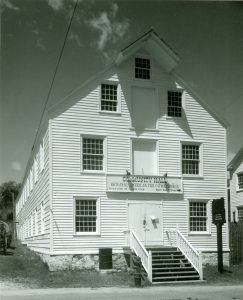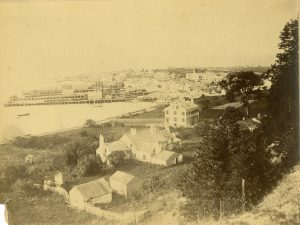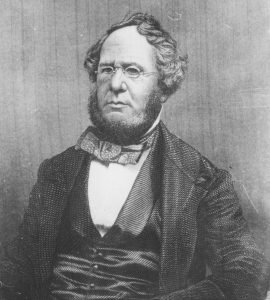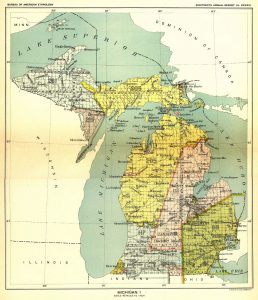
Modern visitors to Mackinac Island still have a chance to see numerous reminders of the community’s heyday as a center of the Great Lakes fur trade. Walking down Market Street, it’s hard to miss the large cream-colored buildings that once belonged to the American Fur Company (today the Community Hall and Stuart House Museum) or the original Michilimackinac County Courthouse, built in the late 1830s. Fort Mackinac still looms over the town and harbor. However, just below and east of the fort, there once stood another complex of buildings which reflected Mackinac’s key role in not only the regional economy, about also in the federal government’s relationship with the Anishnaabek and other indigenous people of Michigan. Although largely gone today, the Mackinac Indian Agency was a critical part of the island community for much of the early 19th century.
In the 1780s and 1790s, after a series of stinging defeats at the hands of the tribes of the Great Lakes, the new United States government adopted a broad policy of conciliation and treaty-making with indigenous groups. Rather than automatically attempting to subjugate the tribes with military force, the government embarked on a program to “civilize” Native people and transform them into white American citizens. Treaties with the Anishnaabek and other indigenous groups, in which the tribes ceded land to the federal government in return for goods and services, were a key feature of the civilization program, which continued in some form well into the 20th century. To carry out treaty provisions and distribute the goods and annuity payments promised in negotiations with the tribes, Indian agencies were established around to the country to act as the primary point of contact between indigenous people and the federal government.

The first agency in Michigan opened on Mackinac Island in 1815, shortly after the island returned to American control following the War of 1812. The first agent, William Puthuff, concentrated on diminishing British influence among the tribes of northern Michigan, many of whom fought against the United States during the war, and enforcing trade regulations, which drew the ire of the powerful American Fur Company. Puthuff was soon replaced, but subsequent agents continued the work of providing government goods and services to the regional Anishnaabek, thousands of whom visited Mackinac every summer. The Mackinac Agency was centered around the agent’s house, which served as a residence for the agent as well as a warehouse for government goods. A sprawling structure with two wings, it was surrounded by well-tended gardens. Writing in 1835, a traveler described it as a “very comfortable house,” which presented a “conspicuous figure, being well situated at the fort of the hill, with a good garden in front.”

In 1833 perhaps the most consequential (and controversial) of the Mackinac Indian agents arrived on the island: Henry Schoolcraft. Schoolcraft previously served as agent at the Sault Ste. Marie Agency, where he married into a prominent Ojibwa family. He used his position to ensure that his wife Jane’s extended Anishnaabek family reaped federal benefits, and wrote extensively about Anishnaabek history and culture. As the Mackinac agent, which also served as Michigan’s superintendent of Indian affairs after 1836, Schoolcraft oversaw negotiations for the 1836 Treaty of Washington. This agreement saw the Anishnaabek of northern Michigan cede 14 million acres of their land in return for annuity payments, regular distribution of food and supplies, payment of debts, and other provisions. The treaty helped clear Michigan’s path to statehood, but left the Anishnaabek unsure of their future in northern Michigan.

With the new treaty grudgingly ratified by the Anishnaabek on Mackinac Island in the summer of 1836, the agency continued to serve as a critical point of contact with the federal government. In 1838 Schoolcraft supervised the construction of a dormitory building to house visiting Native people (the building went largely unused, as they preferred to camp on the beach). By 1839 the agency employed several people: a dormitory keeper, a physician, two interpreters, four blacksmiths, a gunsmith, two carpenters, three farmers, and Schoolcraft himself. Workshops lined the base of the bluff behind the dorm. In keeping with federal policy, these employees were to provide services and education in an effort to force the Anishnaabek to abandon their traditional culture and adopt the lifestyle of white American farmers.
Despite its importance in the 1830s, the Mackinac Agency gradually fell into obsolescence as federal policies changed and the government focused more on tribes of the far west. Since the agents were always political appointees, they came and went as presidential administrations changed (Schoolcraft lost his post in 1841). Indian affairs were consolidated at the Mackinac Agency through the 1850s, and the Michigan superintendent’s office moved to Detroit in 1851. Agents only returned to Mackinac to distribute summer annuity payments, and the old agent’s house was rented out and gradually fell into disrepair. The house was described in Constance Fenimore Woolson’s 1880 novel, Anne, and several of her other writings, which were partially set on Mackinac Island. The dormitory served as the island’s public school beginning in the late 1860s.

Today, the Mackinac Agency is largely invisible on the landscape. The site of the old agency house and gardens is now occupied by summer cottages. A playground and the Mackinac Island Peace Garden sit where blacksmiths and gunsmiths once worked. Only the 1838 dormitory, now open to the public as The Richard and Jane Mannogian Mackinac Art Museum, remains standing. Next time you visit Mackinac, stop by the art museum and consider the building’s previous life as part of the agency. If you would like to learn more about the agency, join Chief Curator Craig Wilson outside the art museum at 5:00 PM on Tuesday, June 8, 2021 for a free walking tour describing Mackinac Island’s bustling community of the 1830s.









